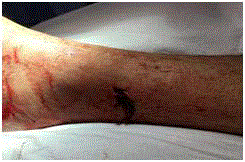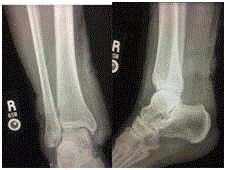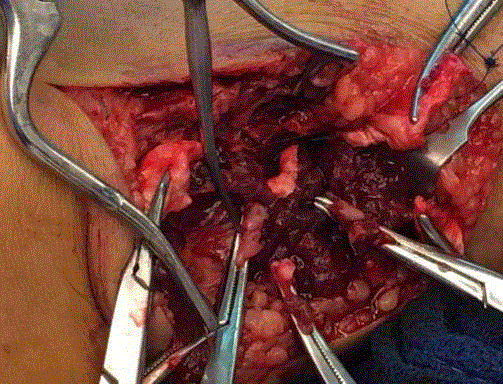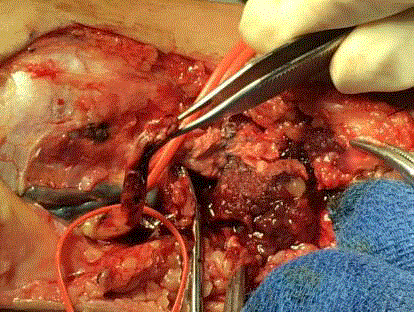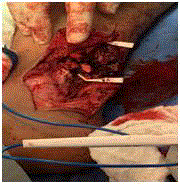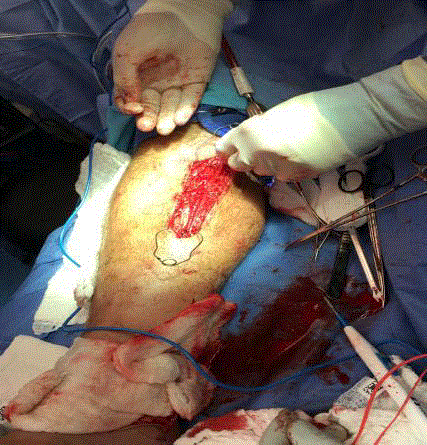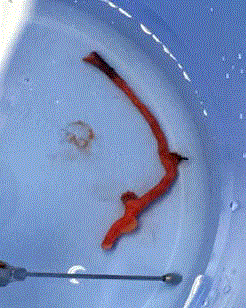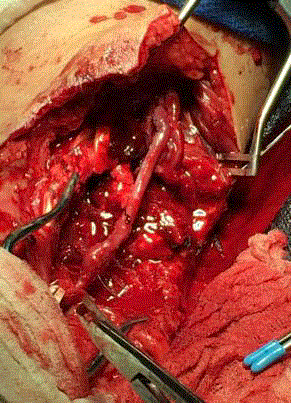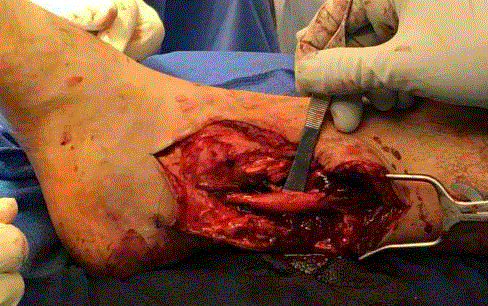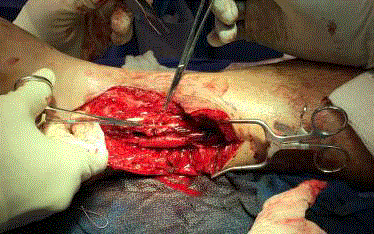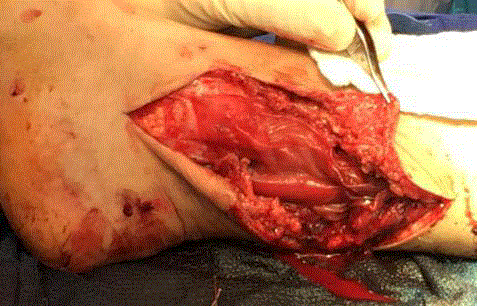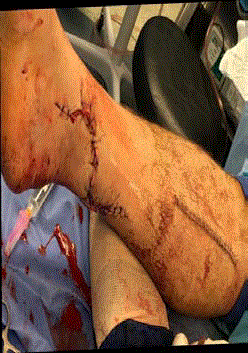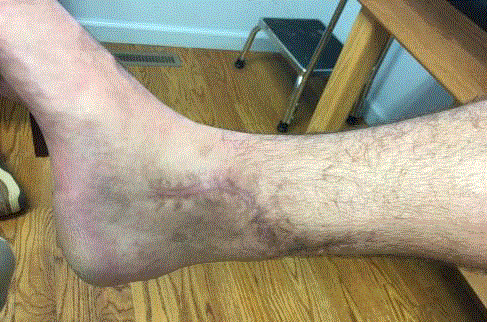Case Report
Tarsal Tunnel Laceration: A Comprehensive Limb Salvage Surgical Procedure
Mark Mendeszoon* and Elizabeth Sanders
Department of Foot and Ankle Orthopedic Surgery, Precision Orthopaedic Specialties, USA
*Corresponding author: Mark Mendeszoon, Department of Foot and Ankle Orthopedic Surgery, Precision Orthopaedic Specialties, USA
Published: 30 Apr, 2018
Cite this article as: Mendeszoon M, Sanders E. Tarsal
Tunnel Laceration: A Comprehensive
Limb Salvage Surgical Procedure. Clin
Surg. 2018; 3: 1956.
Abstract
Vascular injuries in orthopedic trauma can be limb or life threatening. Prompt recognition and early surgical intervention is imperative. The examiner should have a high index of suspicion. We present a case of a healthy 30-year-old male who presented with an acute laceration to the tarsal tunnel. All involved tendons and neurovascular structures in the tarsal tunnel were completely severed. All involved tendons and neurovascular structures were repaired via a tibial artery lesser saphenous vein bypass and direct primary repair of the tibial nerve and all three flexor tendons. A nerve wrap* was utilized protect the tibial nerve and a collagen graft** was used to protect the tendons. Sixteen months from surgical intervention, the patient is back to his usual pre-operative physical activities.
Introduction
Vascular injuries in orthopedic trauma could potentially be limb or life threatening. Physical examination may be subtle or misleading. Prompt recognition and early surgical intervention is imperative when indicated [1-4]. The evaluator should have a high index of suspicion and communicate effectively to the patient and associated healthcare staff. The foot and ankle surgeon should be aware of appropriate imaging modalities, have sound knowledge of relevant surgical techniques, and utilize a multi-disciplinary approach to handle such trauma when possible.
Case Presentation
A 30 year-old healthy male with no significant past medical history presented to the Emergency Room with a deep laceration to his right medial ankle with significant bleeding. The patient works as a construction worker and sustained an injury at work in which a glass pane lacerated his ankle (Figure 1-3). Upon examination in the emergency department, there was an open laceration eight centimeters in length with subtle blood flow. There were palpable pedal pulses present. The foot was noted to be purple in color with some cooling as well as diminished function to the ankle (Figure 4-6). Radiographic images did not reveal fracture or dislocation. However, hazy lucencies in the medial ankle soft tissue were noted indicating fluid and air. Within one hour of presentation, he was taken to the operating room for exploration of the open wound and repair. Appropriate intravenous antibiotics were administered. Thigh tourniquet was placed (Figure 7-10). A “lazy-S” incision was made to extend the incision to approximately 24cm in length. With blunt dissection, a hematoma was expressed and flushed. The posterior tibial tendon, flexor digitorum longus, flexor hallucis longus, and the tibial artery, vein, and nerve were all noted to be completely severed. The proximal and distal posterior tibial artery ends were dissected and cut to fresh edges. The great saphenous vein was harvested utilizing a 10 centimeter medial leg incision just below the knee. Any branches of the vein were divided with silk ligatures and hemoclips. The vein was prepped for anastomosis. The vein was reversed and clipped, then anastomosed with running 6.0 prolene suture (Figure 11). 4500 units of intravenous heparin were administered while vascular clamps were placed. Once the proximal anastomosis was complete, the vascular clamp was removed. An easily palpable graft pulse was observed. A profunda clamp was then placed on the graft as the vein was cut to the appropriate length and tension to anastomose the plantar vessel distally. Once the distal anastomosis was complete, the distal clamp was removed. Inflow and outflow vascular clamps were removed and Doppler confirmed multiphasic signals within the graft in the distal plantar vessel. The arterial bypass area was then protected. The tibial nerve was repaired with an end-to-end anastomosis utilizing a 6.0 prolene. A nerve wrap* 10mm x 4mm long was wrapped around the anastomosed nerve. The posterior tibial tendon, flexor digitorum longus, and flexor hallucis longus tendons were then repaired with an end-to-end anastomosis utilizing #2 fiberwire and then reinforced with a collagen graft** to enhance healing and to minimize scarring and adhesions (Figure 12). The wound was irritated with 2 liters of high-pressure impregnated saline. The flaps were re-approximated with a 2.0 Vicryl suture followed by 2.0 and 3.0 prolene sutures. The bypass surgical site was approximated with deep vicryl sutures and skin staples. Posterior splint was placed and the patient was advised to remain non-weight bearing. Post-operatively, the patient remained non-weightbearing. Three weeks post-operatively the patient was weight bearing to tolerance in a surgical boot. Six weeks postoperatively, the patient transitioned to a regular shoe and underwent physical therapy. Seven months from surgery, non-invasive vascular studies demonstrated normal peripheral arterial perfusion, normal pulse volume recordings with a patent bypass graft. Sixteen months from surgery, the patient is back to work and back to his usual physical activities in regular shoes with only diminished sensation to the plantar sole of his foot and normal musculoskeletal strength of the limb and gait pattern (Figure 13).
Figure 1
Figure 2
Figure 2
Radiographic images of a tarsal tunnel trauma. Soft tissue lucency
to the medial ankle demonstrating hematoma formation in the tarsal tunnel.
Figure 3
Figure 3
The tarsal tunnel demonstrating the posterior tibial tendon, flexor
digitorum longus, flexor hallucis longus, and the tibial artery, vein, and nerve
all completely severed.
Figure 4
Figure 5
Figure 6
Figure 6
Harvesting of the greater saphenous vein utilizing a 10cm medial
leg incision just below the knee.
Figure 7
Figure 8
Figure 9
Figure 10
Figure 10
Repair of the posterior tibial tendon with an end-to-end
anastomosis utilizing #2 fiber wire.
Figure 11
Figure 11
Repair of all elements of the tarsal tunnel including collagen wrap
protector** around the tendons just prior to closure.
Figure 12
Figure 13
Figure 13
Sixteen months status-post tarsal tunnel trauma repair. The
incision sites are healed. The patient has excellent range of motion and no
pain.
Discussion
This healthy 30-year-old male presented with an acute laceration to the medial ankle that resulted in all tendons and neurovascular structures in the tarsal tunnel completely severed [1]. The vascular surgeon was able to perform a tibial bypass utilizing a reversed saphenous vein and all pertinent structures were repaired appropriately. Sixteen months from surgery, patient is back to his typical physical activities with no limitations [2-5]. When presented with open lower extremity injuries, the evaluator should have a high index of suspicion for involvement of neurovascular structures. Prompt recognition and early surgical intervention is warranted as well as appropriate antibiotic administration and medical management [6-8]. The surgeon should have sound knowledge of relevant surgical techniques and utilize a multi-disciplinary approach when possible.
References
- Downey MS. A guide to nerve wrapping for tarsal tunnel.Podiatry Today. 2015;28(12):32-9.
- Horton RE. Injury to the posterior tibial artery complicating fracture of the tibia.BJS. 1968;55(2):93-5.
- Integra® neurawrap nerve protector product guide. Integra LifeSciences Corporation. Plainsboro NJ.
- Integra® TenoGlide Tendon Protector Product Guide. Integra LifeSciences Corporation. Plainsboro NJ.
- Mahan KT. Tendon Trauma: Laceration and Rupture. 1988;54-7.
- Mavrogenis AF, Panagopoulos GN, Kokkalis ZT, Koulouvaris P, Megaloikonomos PD,Igoumenou V, et al. Vascular Injury in Orthopedic Trauma. Orthopedics.2016;39(4):249-59.
- McDonald M, Eberhardt KN, Estrada RJ. Traumatic laceration of the posterior tibial artery. J Foot Ankle Surg. 1993;32(3):291-4.
- Mezrow CK, Sanger JR, Matloub HS. Acute tarsal tunnel syndrome following partial avulsion of the flexor hallucis longus muscle: A case report. J Foot Ankle Surg. 2002;41(4):243-6.

